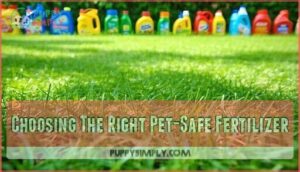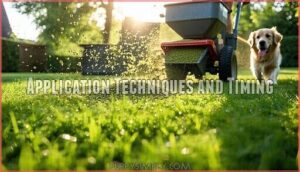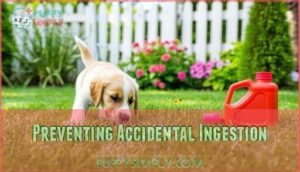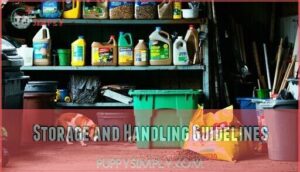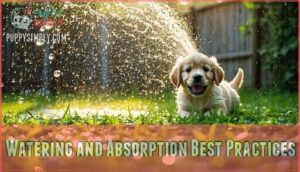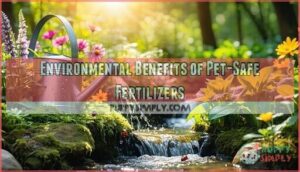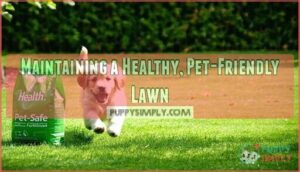This site is supported by our readers. We may earn a commission, at no cost to you, if you purchase through links.
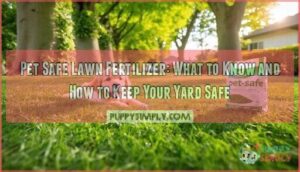 Your dog doesn’t know the difference between a sunny patch of grass and a chemical minefield. Every time your pet rolls in the lawn or licks their paws after a romp outside, they’re potentially exposed to toxins from conventional fertilizers.
Your dog doesn’t know the difference between a sunny patch of grass and a chemical minefield. Every time your pet rolls in the lawn or licks their paws after a romp outside, they’re potentially exposed to toxins from conventional fertilizers.
Many synthetic products contain ingredients like disulfoton and heavy metals that can trigger vomiting, diarrhea, and worse. Pet-safe lawn fertilizer offers a solution that keeps your grass green without putting your four-legged family member at risk.
Understanding what makes these products different—and how to use them properly—protects both your pet’s health and your lawn’s vitality.
Table Of Contents
- Key Takeaways
- What Makes Lawn Fertilizer Pet Safe?
- Choosing The Right Pet-Safe Fertilizer
- Safe Fertilizer Application Around Pets
- Environmental Benefits of Pet-Safe Fertilizers
- Maintaining a Healthy, Pet-Friendly Lawn
- Frequently Asked Questions (FAQs)
- What lawn fertilizers are safe for dogs?
- Is Scotts lawn fertilizer safe for pets?
- When can pets go on lawn after fertilizing?
- Is Bermuda grass fertilizer safe for dogs?
- Are there DIY alternatives to pet-safe fertilizers?
- Do pet-safe fertilizers break down faster in soil?
- How often should you fertilize pet-friendly lawns?
- Can pets go outside immediately after rain?
- Do pet-safe fertilizers work on all grass?
- Whats the shelf life of organic fertilizers?
- Conclusion
Key Takeaways
- Pet-safe fertilizers use organic ingredients like feather meal and compost instead of synthetic chemicals that can cause vomiting, tremors, and gastrointestinal distress in pets.
- Wait 24 to 48 hours after applying any fertilizer before letting pets back on the lawn, and water deeply right after application to help nutrients absorb into soil and reduce surface residue.
- OMRI-certified fertilizers meet strict organic standards and release nutrients slowly over time, which protects both your pet’s health and local water sources from harmful runoff.
- Natural lawn care practices like aerating twice yearly, composting grass clippings, and encouraging beneficial insects create a thriving yard without exposing pets to toxic pesticides or herbicides.
What Makes Lawn Fertilizer Pet Safe?
Regarding your pets and your lawn, not all fertilizers are created equal. There are a few things you’ll want to look out for to keep your furry friends safe.
Here’s what really sets pet-safe options apart.
Toxic Ingredients to Avoid
Even a healthy-looking lawn can hide dangers. Toxic substances to watch for include synthetic herbicides, heavy metals like arsenic and cadmium, and inert ingredients, which are sometimes more hazardous than active ones.
Synthetic chemicals and products with disulfoton or pesticides pose real risks. Many common lawn treatments contain harmful lawn pesticides that can be dangerous.
Know these potential dangers of lawn fertilizers to keep your pets safe from harmful chemicals and fertilizer poisoning.
Common Symptoms of Fertilizer Poisoning
Spotting symptoms of fertilizer poisoning in pets often starts with their stomachs. Vomiting or diarrhea, usually within 2 to 10 hours after pet ingestion, is common.
You’ll also see:
- Gastrointestinal distress (loss of appetite, hypersalivation)
- Neurological effects (tremors, muscle stiffness)
- Allergy symptoms (skin rash, facial swelling)
- Symptom severity varies—quick veterinary care helps most recover fast. Organic fertilizers can increase the risk of fertilizer toxicity in dogs.
OMRI Certification and Its Importance
If you want to be sure a product truly is “pet safe,” look for the OMRI seal. This badge means the fertilizer meets strict OMRI Standards: every ingredient passes a tough Certification Process with real oversight.
OMRI-listed fertilizers are safe for pets, support organic lawn care, protect your soil, and—thanks to their slow-release formulas—offer strong Consumer Benefits and Environmental Impact.
Differences Between Organic and Synthetic Fertilizers
Once you’ve spotted the OMRI seal, it helps to know how organic fertilizers set themselves apart from synthetic options for your yard and your pets.
Organic fertilizers often offer safer nutrient bioavailability, gentler environmental impact, and more sustainable production processes. While synthetic fertilizers may seem cheaper short-term, the long-term effects generally favor the benefits of organic fertilizers—especially for your pets’ safety.
Choosing The Right Pet-Safe Fertilizer
Picking the right pet-safe fertilizer can feel a bit overwhelming, but you do have good options.
A few key things help set safe products apart. Here’s what to look for when you’re making your choice.
Types of Pet-Friendly Fertilizers
Looking at your options for pet-friendly lawn fertilizer, you’ll find a garden full of choices. Organic compost, grass clippings, and seaweed kelp offer slow, steady feeding. Plant-based blends and fish emulsion deliver nutrients without harsh chemicals.
Each covers safe lawn fertilization practices. Choosing pet-friendly fertilizer means supporting a healthy yard while keeping your pets out of harm’s way.
Natural Ingredients to Look For
When you’re picking out a pet-safe fertilizer, it helps to know which natural ingredients actually work wonders for your lawn and your furry friends. Look for:
- Plant byproducts like soy hydrolysate
- Animal manure for steady natural nutrients
- Feather meal for nitrogen boost
- Fish emulsion or compost for gentle, organic fertilizers
All keep things simple and safe.
Avoiding Insecticides and Snail Bait
If your pets spend time on the grass, steering clear of insecticides and snail bait goes a long way toward keeping them safe.
Try Bait Alternatives or Natural Repellents for weed control and pest issues. Targeted Application helps limit risks, and always use Safe Disposal for any leftovers.
Regular Pet Monitoring means you can spot trouble before toxic chemicals become a petsafe problem.
Safe Fertilizer Application Around Pets
Getting fertilizer down safely is just as important as which kind you choose. If you want your yard to stay safe for pets, a little extra care goes a long way.
Here’s what you’ll want to keep in mind as you get started.
Application Techniques and Timing
Applying fertilizer at the right time can make your lawn safer for your pets and keep your grass growing strong all season.
Use spreader calibration and the right fertilizer spreader settings for targeted application. For effective results, match seasonal timing to your grass type.
Opt for granular or liquid pet-safe options, follow proper fertilizer application guidelines, and water your lawn after fertilization for best post-application care.
Preventing Accidental Ingestion
Ever notice how dogs seem to sniff out trouble—and sometimes taste it before you get the chance to say no? Keep pets away from fertilized areas for 24 to 48 hours after application. Symptoms of fertilizer poisoning in pets include vomiting and drooling.
Store bags in sealed containers to prevent pet ingestion. Child safety considerations matter too. Consider taste aversion training or switching to alternative fertilizers for added protection.
Storage and Handling Guidelines
A forgotten bag of fertilizer in the garage can be just as risky as anything you spread on your lawn. Store fertilizer in sealed containers on high shelves where pets and kids can’t reach them.
Check product labeling for shelf life and disposal instructions. Clean up spills immediately to prevent pet exposure.
Proper fertilizer storage and pet safety go hand in hand—don’t let curiosity lead to a trip to the vet.
Watering and Absorption Best Practices
Once you apply fertilizer, water helps move nutrients into the soil and keeps granules from sticking to your pet’s paws. Post-application watering speeds up granule absorption and reduces surface residue by up to 80% within an hour.
Follow these watering lawn after fertilization tips:
- Water deeply right after application for fast absorption
- Maintain consistent soil moisture to support nutrient uptake
- Irrigate enough to prevent runoff and chemical pooling
- Check that granules dissolve completely before allowing pet access
- Wait 24-48 hours before letting pets return to treated areas
Environmental Benefits of Pet-Safe Fertilizers
Choosing pet-safe fertilizers helps more than just your dog or cat. These products cut down on harmful runoff that pollutes local water sources.
They also support long-term soil health and break down naturally without leaving chemical residue behind.
Reducing Water Pollution and Runoff
When you choose pet-safe fertilizers, you’re protecting more than your yard. Traditional fertilizers send nitrogen and phosphorus straight into stormwater systems, fueling toxic algal blooms and groundwater contamination.
Pet-safe fertilizers protect waterways by preventing nitrogen and phosphorus runoff that fuels toxic algal blooms and groundwater contamination
Organic fertilizer benefits include slow-release formulations that cut nutrient runoff by up to 40%. Safe application practices like soil testing and proper timing keep water sources clean while reducing environmental risks of fertilizing responsibly.
Biodegradable and Sustainable Formulas
Pet-safe fertilizers don’t just protect your dog or cat—they break down naturally without leaving synthetic residues in your soil or water supply. Organic lawn fertilizer options made from plant or animal byproducts offer sustainable sourcing with a lower carbon footprint. Here’s what makes them work:
- Nontoxic ingredients reduce runoff and environmental impact
- Eco-friendly packaging minimizes long-term waste
- Organic lawn care encourages healthier ecosystems over time
Soil and Lawn Health Improvements
Beyond breaking down safely, these organic formulas actually strengthen your soil and turf from the ground up. They boost microbial activity by nearly 30% over one season, aiding nutrient cycling and improving soil composition.
You’ll see stronger root development within 8 to 12 weeks. Nitrogen release happens slowly and steadily, ensuring better water retention and healthier lawn growth without chemical spikes.
Maintaining a Healthy, Pet-Friendly Lawn
A healthy lawn takes more than just safe fertilizer. You need ongoing care that protects your grass and your pets at the same time.
Here are the key practices that keep your yard thriving without putting your furry friends at risk.
Composting and Mulching Tips
Composting your lawn clippings and adding mulch can feed your soil without opening a bag of store-bought fertilizer. Here are five ways to make the most of these organic methods:
- Mix yard clippings with kitchen scraps for balanced compost ingredients.
- Use natural mulch types like shredded bark or wood chips.
- Apply a two to three inch mulch layer for soil enrichment and natural weed control.
- Turn your compost pile regularly to speed decomposition.
- Keep mulch away from plant stems to prevent rot.
Aerating and Watering Strategies
Your lawn needs air and water in the right amounts to stay strong enough for pets to enjoy. Aerate once or twice yearly to relieve soil compaction and boost nutrient uptake in the root zone.
Water deeply but less often to encourage deep roots and support overseeding. This approach improves soil health while reducing pet exposure to surface chemicals and conserving water through smarter irrigation.
Long-Term Lawn Care Practices for Pet Safety
Building a pet-friendly lawn isn’t a one-time fix but a steady rhythm of care that protects both grass and animals year after year. Choose resilient grass varieties that tolerate pet traffic.
Mow high to strengthen roots and improve soil health. Overseed thin spots regularly to maintain lawn health.
Stick to safe lawn products and rotate your lawn maintenance tasks. This integrated approach keeps your yard thriving while keeping pet health front and center.
Integrating Natural Pest Control Methods
Natural pest control doesn’t mean choosing between a beautiful lawn and your pet’s safety—you can have both with the right approach. Use beneficial nematodes to target grubs without chemicals. Diatomaceous earth controls insects while staying safe for pets.
Try companion planting with pest-resistant grasses to reduce problems naturally. Encourage natural predators like birds and ladybugs.
These organic methods support weed control and create a truly pet-safe yard with natural products.
Frequently Asked Questions (FAQs)
What lawn fertilizers are safe for dogs?
Looking for dog-friendly fertilizers means checking the label first. Organic options from Milorganite and Purely Organic Products skip synthetic herbicides.
Safe fertilizer brands use natural ingredients like feather meal or poultry manure. Always wait 24-48 hours after application before letting pets back on the lawn.
Is Scotts lawn fertilizer safe for pets?
Most Scotts lawn fertilizers aren’t considered pet safe immediately after application. Their products generally contain synthetic chemicals that require a 24-48 hour waiting period before allowing pet access.
Brands like Milorganite or Purely Organic Products offer safer alternatives with natural ingredients.
When can pets go on lawn after fertilizing?
Wait at least 24 to 48 hours after applying pet safe fertilizer before letting pets back on the lawn.
Re-entry timeframe depends on weather influence and activity levels. Breed sensitivities and age considerations also matter when applying pet safe fertilizer for safe lawn care for pets.
Is Bermuda grass fertilizer safe for dogs?
It depends on the formula. Bermuda fertilizer risks vary by brand. Check the label for synthetic herbicides or pesticides.
Pet-safe, dog-friendly options use natural ingredients like feather meal. Fertilizer alternatives include compost.
Soil testing helps determine what your lawn actually needs.
Are there DIY alternatives to pet-safe fertilizers?
Yes, you can make homemade lawn fertilizers using compost, manure, grass clippings, and kitchen scraps. Compost tea and yard clippings work well.
However, DIY recipes carry risks if nutrient ratios aren’t balanced properly.
Do pet-safe fertilizers break down faster in soil?
Most pet-safe fertilizers actually break down more slowly than synthetic ones. That’s because organic materials like feather meal and poultry manure rely on soil microbes to release nitrogen gradually.
This slow-release formula keeps nutrients available longer without harming your pets.
How often should you fertilize pet-friendly lawns?
Most lawns need fertilizer every six to eight weeks during the growing season. Slow-release formulas extend this to ten or twelve weeks.
Soil testing helps determine your specific fertilizer frequency and seasonal needs for best results.
Can pets go outside immediately after rain?
After rain, rainfall dilution and residue wash-off reduce fertilizer absorption risks. However, paw contamination remains possible if puddles form on treated lawns.
For pet safe fertilizer application, wait until surfaces dry to minimize pet exposure to treated lawns and guarantee post-rain safety.
Do pet-safe fertilizers work on all grass?
Most grass types respond well to pet-safe fertilizers.
The key is matching the product’s nutrient ratio to your specific grass. Cool-season grasses like fescue need different nitrogen levels than warm-season varieties like Bermuda or St. Augustine.
Whats the shelf life of organic fertilizers?
Organic fertilizers generally last one to three years when stored properly.
Storage conditions matter most. Keep bags sealed tight in a cool, dry place.
Degradation process speeds up with moisture and heat exposure.
Conclusion
Think of your lawn as a shared space where your pet’s safety and green grass grow from the same roots. Choosing pet safe lawn fertilizer isn’t just about avoiding harmful chemicals—it’s about building soil health that sustains both.
By selecting organic products, timing applications properly, and following watering guidelines, you create a yard where your dog can play without risk. Your lawn becomes what it should be: a safe haven, not a hazard.
- https://www.yourgreenpal.com/blog/pet-safe-lawn-fertilizer
- https://milehighlifescape.com/pet-safe-lawn-fertilizer/
- https://www.lawnstarter.com/blog/lawn-care-2/fertilizer-bad-for-dogs/
- http://jandclawncare.com/blog/are-fertilizers-herbicides-safe-for-kids-pets/
- https://vettechinsights.com/ensuring-pet-safety-while-fertilizing-your-lawn-a-comprehensive-guide-from-a-veterinary-technician

